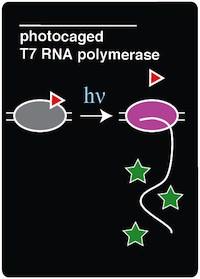Team:Austin Texas/photocage
From 2014.igem.org
| Line 133: | Line 133: | ||
The data from our photocage project provides strong evidence that we have, in fact, replicated the light-activated protein expression system that Chou et al. had constructed. | The data from our photocage project provides strong evidence that we have, in fact, replicated the light-activated protein expression system that Chou et al. had constructed. | ||
| - | From the data, we are able to observe that GFP expression has a positive correlation with the amount of time that it is | + | From the data, we are able to observe that GFP expression has a positive correlation with the amount of time that it is exposed to 365 nm light. Although the difference in fluorescence between 0 minutes and 1 minute appears to be negligible, there was a clear change in fluorescence at the 5 minute, 15 minute, and 30 minute time intervals. |
| - | Although the increases in fluorescence are clearly present, there are still a few problems regarding the system. For one, the level of background expression of the un-induced T7 RNAP is relatively high. The uninduced caged T7 RNAP has roughly 25 times more expression compared to the negative control. The relatively high level of fluorescence may be explained by the efficient nature of T7 RNAP. Even if a few polymerases were "decaged", | + | Although the increases in fluorescence are clearly present, there are still a few problems regarding the system. For one, the level of background expression of the un-induced T7 RNAP is relatively high. The uninduced caged T7 RNAP has roughly 25 times more expression compared to the negative control. The relatively high level of fluorescence may be explained by the efficient nature of T7 RNAP. Even if a few polymerases were "decaged" by spurious light during the initial making of the culture or during transfers, the decaged T7 RNAP would have 16 hours to transcribe the RNA the GFP gene. |
| - | + | ||
| + | A potential solution to reduce the background expression of GFP would be to mutate a second amber stop codon into the coding sequence of T7 RNA polymerase. Adding a second stop codon would theoretically reduce the number of T7 RNA polymerases that are being transcribed. If a second amber stop codon were introduced into the coding sequence of T7 RNAP, it would be beneficial for it to be at another potentially vital site in the enzyme such as Y427. This is important if the incorporated ONBY at 639 is being decaged at times other than the exposure to 365 nm light. Another possible location of the second amber stop codon would be near the start of the sequence, such as at Y116. Placing an amber stop codon at the beginning of the sequence would prematurely halt the translation in the absence of ONBY, and this would be important if misincorporation is the cause of the high background fluorescence. Either of these solutions could potentially reduce the background. | ||
| + | |||
| + | A third potential solution would be to redesign the entire plasmid containing the T7 RNAP to reduce the amount of T7 RNAP that is made by the cell. This could be through a lower copy number plasmid or choosing a different promoter sequence for the purpose of slowing down gene expression. | ||
| + | |||
| + | The recreation of this light-activatible gene expression system provides a potential foundation for future iGEM projects that wish to use light to control gene expression. By replacing the GFP reporter with coding sequences for other proteins, we will be able to explore novel applications of light-activated protein expression. | ||
<h1>References</h1> | <h1>References</h1> | ||
Revision as of 19:30, 17 October 2014
| |||||||||||||||||||||||||||||
 "
"




